The
1700
girls
of
Doctor
Rakh
Text, photographies and web design: Bernat Parera
From the city of Pune, Doctor Ganesh Rakh fights against the stigma that is having a girl in India, a country that appears to not love its daughters. For 9 years he has offered free deliveries to mothers who give birth to a girl.
The day Jaya gave birth, she heard four words that shook her to her core, “It’s a girl”. For the next few months her husband reminded her with his fists that he had wanted a boy, until he felt that it was insufficient and threw a can of acid on her face and body.
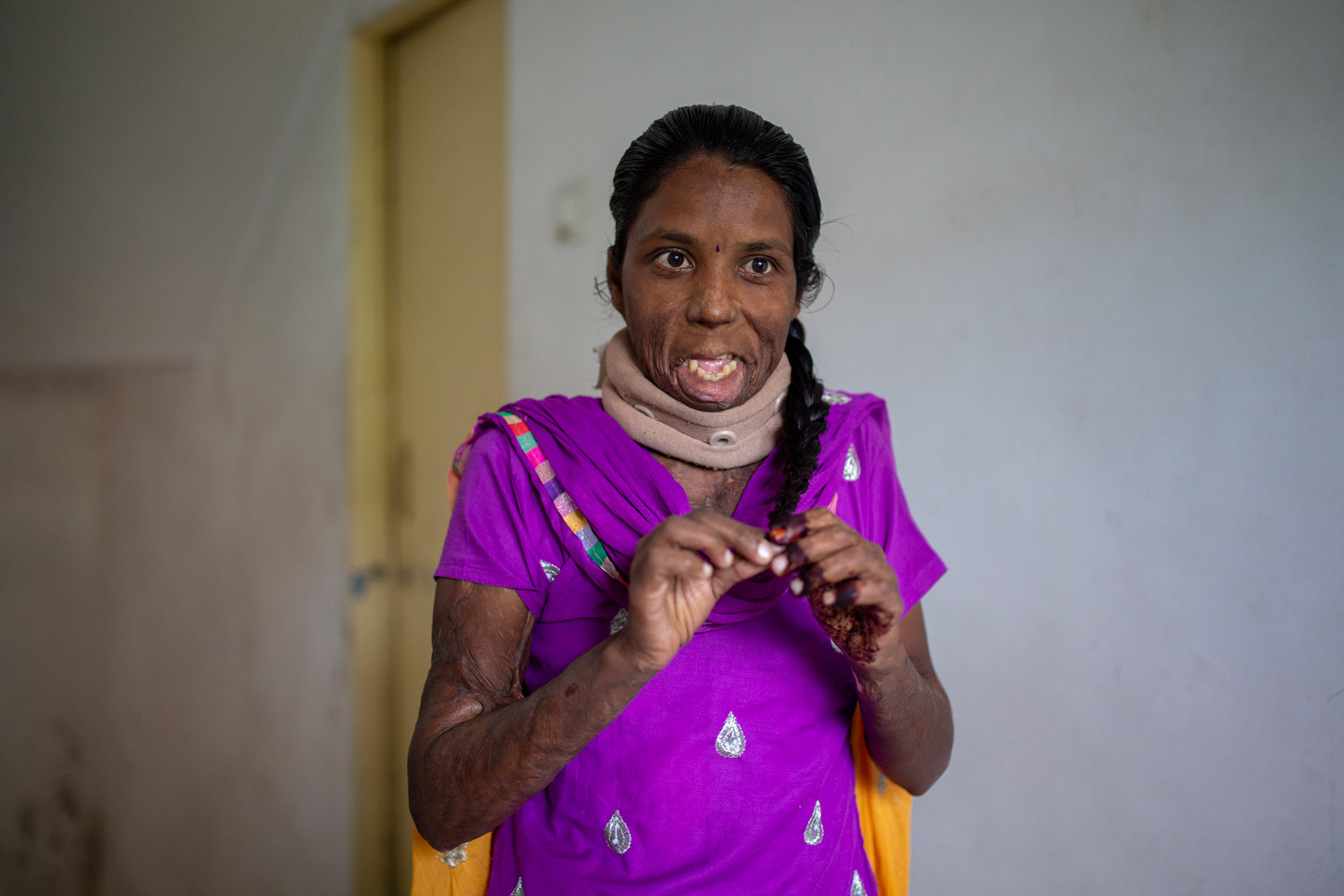
Jaya talks to the nurses as she fiddles with her ponytail at Pune Medicare Hospital Medicare de Pune
Nurse Seema’s wizened hands struggle to pull Jaya’s hair into a ponytail. Tall, slim, dark and young, Jaya’s face is split in two by the acid. She has been bedridden for several weeks at the Medicare Hospital, run by Dr. Rakh, in Pune, a city of three million in western India. Her hands, held close to her chest, are useless, hardly mobile. Thirteen years have passed since the day she gave birth to a non-boy and her husband attacked her.
Acid is the most cruel of liquids. When we are attacked, common sense tells us to shrink and minimize the exposed surface of our body. But acid does not just burn the skin, it melts it. If our arm is next to the trunk of our body, it will bind them; if our chin is pressed against our chest, the acid will melt them. A single can of acid can turn a woman into a tangle of skin and flesh.
30 rupees – barely half a euro – is the cost of a litre of revenge in India. In 2013 the Supreme Court regulated the sale of acid in the country. The buyer is required to provide identification and establish the purpose of the purchase, but as with many other laws in India, it has not been enforced and acid is freely sold on the streets.
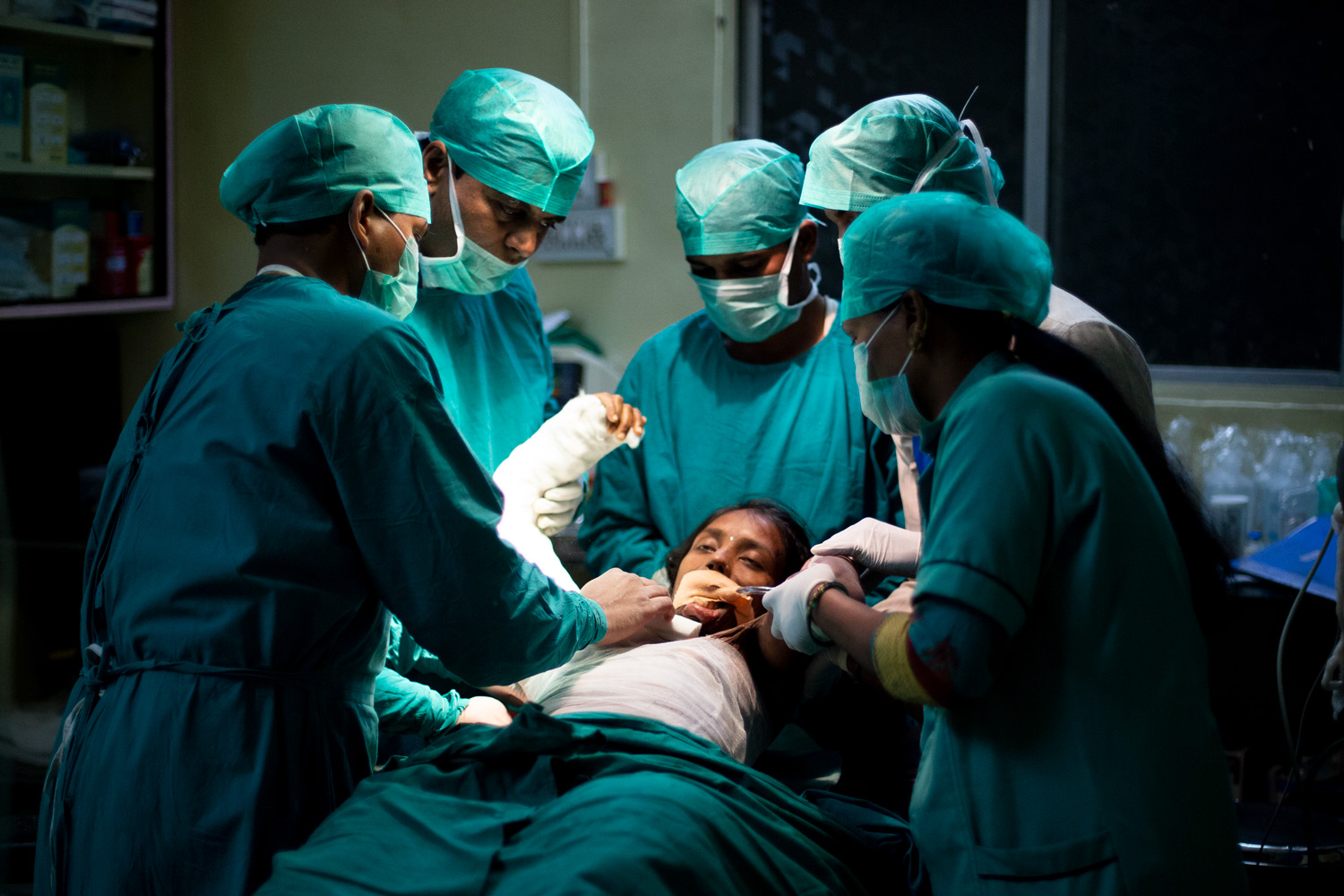
Operation to separate the arm from the body of Jaya, a survivor of an acid attack.
As the acid fed on Jaya’s body, her husband locked her in a room and left her for dead. Hours later, realising she was still breathing and scared at the prospect of ending up in jail, he took her to a hospital. “In the police report, they wrote up the incident as a domestic accident. While I was unconscious, they used my thumb to sign the statement,” says Jaya.
“In the police report, they wrote up the incident as a domestic accident. While I was unconscious, they used my thumb to sign the statement”
Saving their daughter’s life cost Jaya’s parents money they didn’t have. Labourers without land, to pay the bill for her treatment, they sold what little they had and went into debt: a cow and a loan to be repaid over three lives. 40 thousand rupees or about 490 euros. There was no Dr Rakh at the time to take care of the bill.
Watch Jaya tell her story.
In India, 25 women are attacked with acid every month. On numerous occasions, the dowry, or more accurately an insufficient one, is the reason behind these attacks. In Jaya’s case, the attempted murder was not only punishment for having mothered a girl. Her in-laws had always found inadequate the 35 thousand rupees (about 430 euros) dowry that Jaya’s parents paid for her to marry her first cousin.
Back in 2016, eight years after the attack, Jaya laid in a cot in the intensive care unit, wearing a faded red nightgown with the hospital’s name embroidered in yellow letters. Sitting at the foot of her bed, her brother Satish spent time helping to balance the hospital’s pharmacy bills. They had been in the hospital for days, waiting for Jaya to gather enough strength to endure one of the many surgeries required to undo the damage the acid had wrought on her body. She was so weak that the nurses had to collect blood to test from her ankles.
Jaya’s long journey to regain mobility of her body, racked by violence as a consequence of the birth of her daughter, was just beginning. “My husband should be in prison, my husband and my mother-in-law,” said Jaya from her bed.
Watch one of the operation theaters in the hospital in 360º
NO COUNTRY FOR GIRLS

Dr Rakh and a nurse examine a crying newborn girl in the incubator.
More than 63 million girls are missing in India. Greater than the population of Spain and Portugal combined. Years of selective abortions and female infanticide, along with the fact that families stop having children once they have a son, have led to this anomalous situation. The preference towards a male child at the time of feeding or vaccinating children has meant that girls up to the age of 5 years are 50 percent more likely to die than boys from the same age group. Every four minutes, a girl dies from discrimination in the country.
Behind this ‘gendercide’ are some long held traditions of the subcontinent. India has advanced since the ban on Sati, the burning of a widow on her husband’s funeral pyre, and it was abolished entirely in 1987. But the prohibition on the dowry – the price bridal families pay to marry off their daughters – has had no effect and remains the norm for weddings across the country and its neighbours Pakistan and Bangladesh. For humble families, having one daughter or more can mean bankruptcy.
Despite the fact that the Indian government outlawed ultrasound scans to determine the sex of fetuses in 1994, abortions of girls have increased in recent years. Sex determination is a lucrative business – “pay now, save later” is the slogan used by some of the clandestine clinics that run these schemes. In March 2017, about 200 kilometres south of Pune, the police found a plastic bag with 19 baby girl fetuses near a clinic suspected of performing selective abortions.
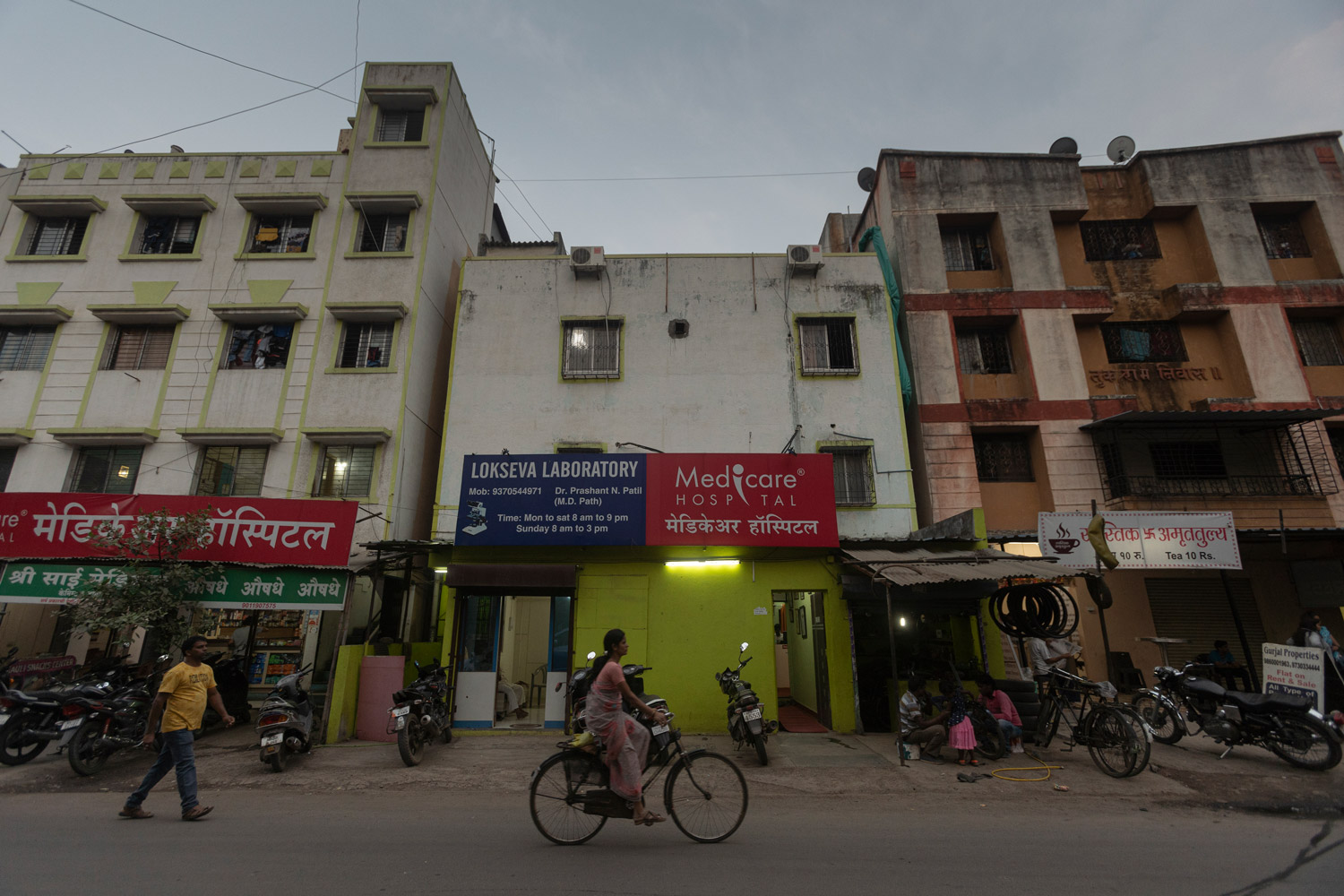
A woman in a bicycle crosses the Medicare Hospital.
In the state of Maharashtra – where Dr Rakh’s hospital is located – from 2001 to 2011, the number of girls aged 0 to 6 per 1,000 boys decreased from 913 to 894. The World Health Organisation states that a healthy society should have 953 girls for every 1,000 boys.
During pregnancy, some families rely on quacks who promise the birth of a boy in exchange for a few rupees. Dr Rakh tells of a couple who went to his hospital to give birth. “When their daughter was born, they were enraged and accused the nurses of having changed the boy for a girl. We had to show them the whole hospital so that they could see that there were no other children that day, and they calmed down.”
To the north of the country, in Haryana, the state with the worst ratio between men and women, the Avivahit Purush Sangathan (the Union of Single Men) in 2014 offered politicians from the different parties votes in exchange for wives. Haryana is one of the epicentres of bride trafficking in India. Traffickers get girls from the eastern states of India under false promises of work and then sell them there as wives for between 10 to 50 thousand rupees.
At the hospital, the doctor tears a piece of paper from a notepad and begins to draw a circle. “In India, fewer and fewer girls are being born. Fewer girls mean there are fewer women to marry. Men do not find a partner and remain single, and this creates insecurity for women. And this deters families from wanting to have daughters,” he says while he points to the circle with the pencil. “It is a vicious cycle”.
39 CRIMES AGAINST WOMEN EVERY HOUR
Every 15 minutes, a woman is raped in the country
Everyday, six women are gang-raped
Every 69 minutes, a bride is killed due to disputes over her dowry
Every month, 25 women are attacked with acid
Watch Doctor Rakh working in his hospital.
The boy who wanted to be a fighter
There are two turning points in the life of Ganesh Rakh. 23 years, eight months and four days separate them.
The first was the day his father took him to learn about hard work. He was 12 and dreamed of being a kushti fighter – the traditional art of Indian wrestling. Twelve hours working as a porter in the wake of his father made him understand that studying led to a better future. “Loading grain is the worst experience I have ever had. The heat is unbearable and you have to work barefoot carrying extremely heavy sacks of grain,” says Dr. Rakh. That summer, Ganesh’s stiff back turned him from a mediocre to model student.
The second is the day that he sat around a table with his wife, parents and two brothers to discuss a crazy, almost revolutionary, idea. The epiphany of Ganesh Rakh – “I want families who give birth to girls in the hospital to not pay.”
For the doctor, it was a considered, almost instinctive decision. Collecting money from parents giving birth to girls had become an arduous and exhausting task that often resulted in either a call to the police or having to offer discounts to parents to cushion the disappointment of having a girl.
For Dr. Rakh’s family, it was madness, a nonsensical idea. In 2012, the hospital was not doing well, its expenses statement showed that it had accumulated more than 100,000 euros of debt in salaries, loans and unpaid machinery. “The situation was so bad that we did not even have 60 rupees to pay for a haircut for Tanisha,” said Trupti, Dr. Rakh’s wife, referring to their daughter.“I said no. What were we going to live on?”
To understand their reaction, one has to know the journey of the Rakh family, from landless labourers to hospital owners. Dr. Rakh’s gamble could send them back into poverty.
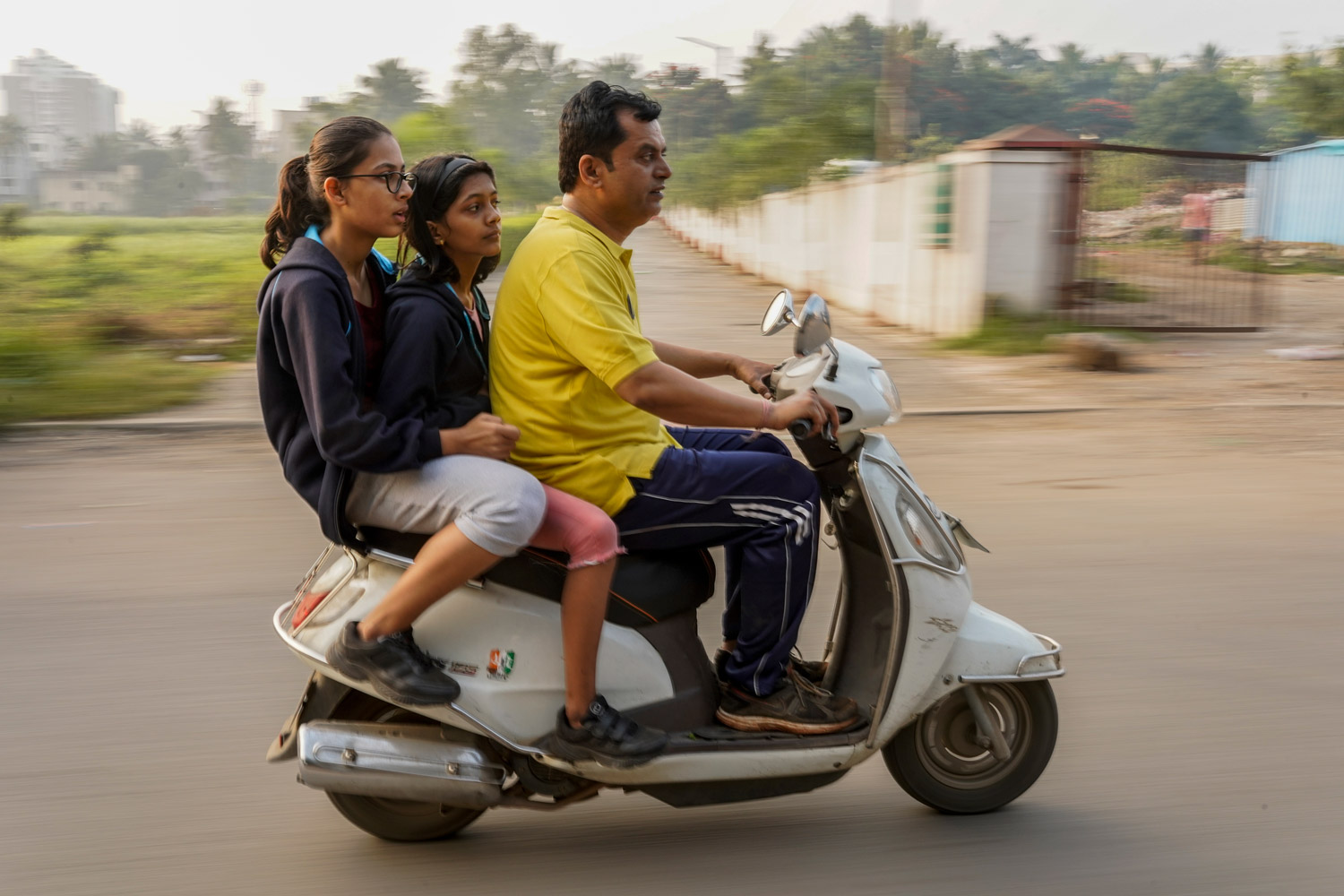
Doctor Rakh, his niece and his daughter travel by motorcycle to the park where they practice sport every morning.
Until he was nine, Ganesh Rakh lived in Vanjarwadi, a village with hardly any houses, an inhospitable place where year after year, the few families that survived there rode drought after drought. Until it was impossible. In the 1980s, 90 percent of Vanjarwadi’s population was forced to emigrate. The doctor’s family moved to Pune, 150 kilometers to the west. They exchanged a few square metres of straw and adobe for four square metres of sheet metal in a city slum.
From there little Ganesh climbed the social ladder step by step, with his elbows glued to books, until the beginning of the new millennium, in 2001 when he graduated as a doctor and was able to open a small private practice where he attended to construction workers with snake bites. Today, three three-storey brick and concrete blocks linked by sturdy metal bridges make up Pune’s Medicare Hospital, the hospital of Dr. Rakh.
Sitting in his office, Dr. Rakh – of gentle voice, kind features and tranquil gaze – recounts the story that has got him to this exact position today. Surrounded by awards and recognitions, he returned to that fateful night nine years ago, when his wife, his mother, and his siblings refused to lose their sanity and stop charging for the births of female babies. “In the end, it was my father who held the deciding vote. He said that if necessary, he would go back to work as a porter to pay for the childbirths”, says Dr Rakh. That was 1,700 free deliveries ago.

Dr Rakh examines a newborn girl.
His daughter Tanisha, with an international school English accent, says she wants to be a doctor like her father. Her father jokes that instead he would like her to be a fighter.
The Save the Girl Child movement
The doctor’s Samsung mobile phone never stops ringing or vibrating. Thousands of doctors and activists write to him constantly.
On January 3, 2012, Dr Rakh launched the “Mulghi Vachva Abhiyan (Save the Girl Child)” campaign to fight the stigma of having a girl child in India. Since then, tens of thousands of doctors have joined the movement, offering free or discounted delivery services to families expecting female babies in their practices and hospitals.
His message has crossed the borders of Maharashtra – the state where his hospital is located – reaching almost every state in India. Dr. Rakh has been invited to participate in demonstrations and talks in Nepal, Bangladesh and Pakistan, India’s fraternal arch enemy. Last year he traveled to Zambia to spread his message throughout Africa.
Three years after the doctor’s initiative, on January 23, 2015, the Indian government launched its own campaign “Beti Bachao, Beti Padhao (Save the Girl, Educate the Girl)”.
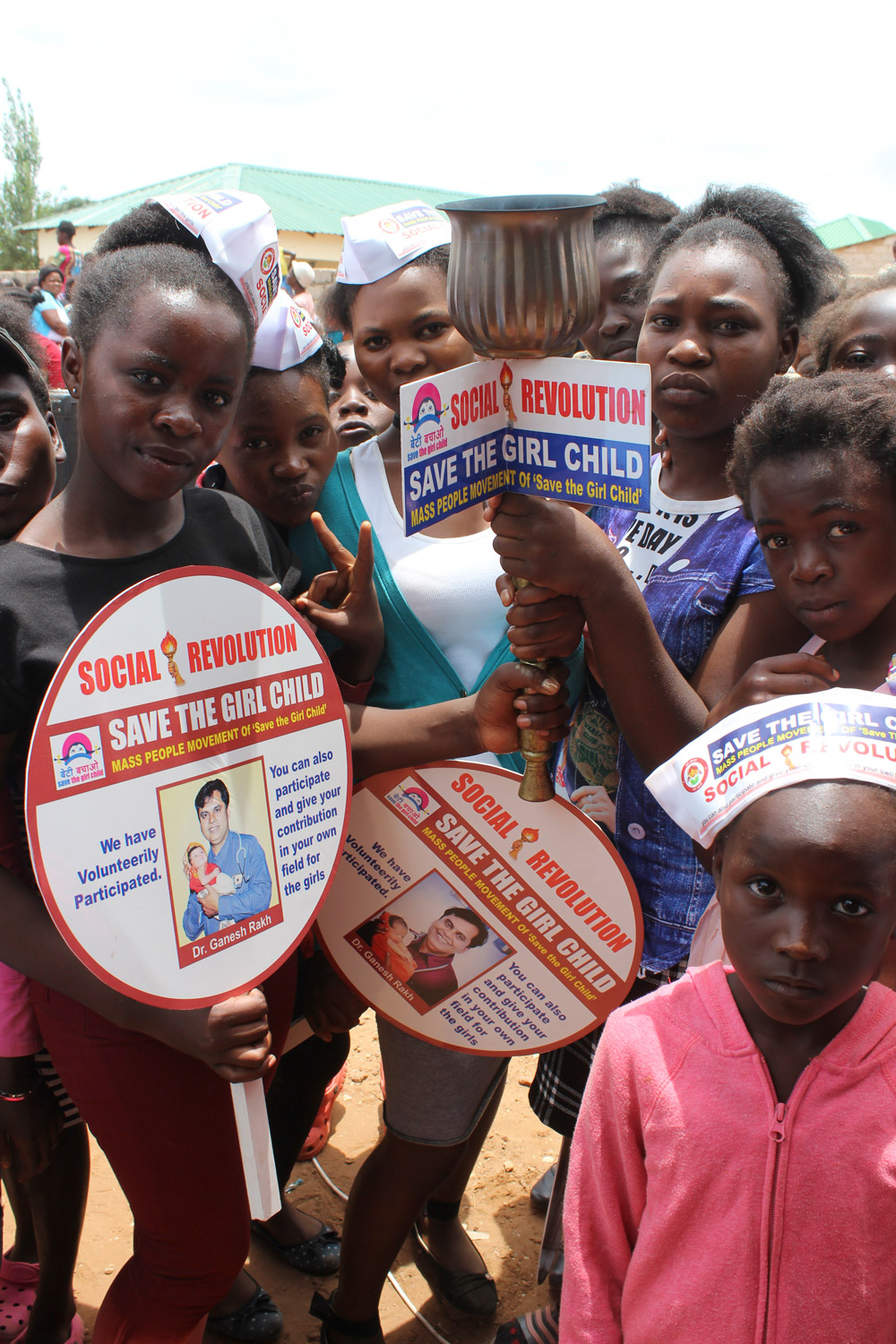
Zambian women demonstrating in favor of Doctor Rakh movement.
celebrating girls
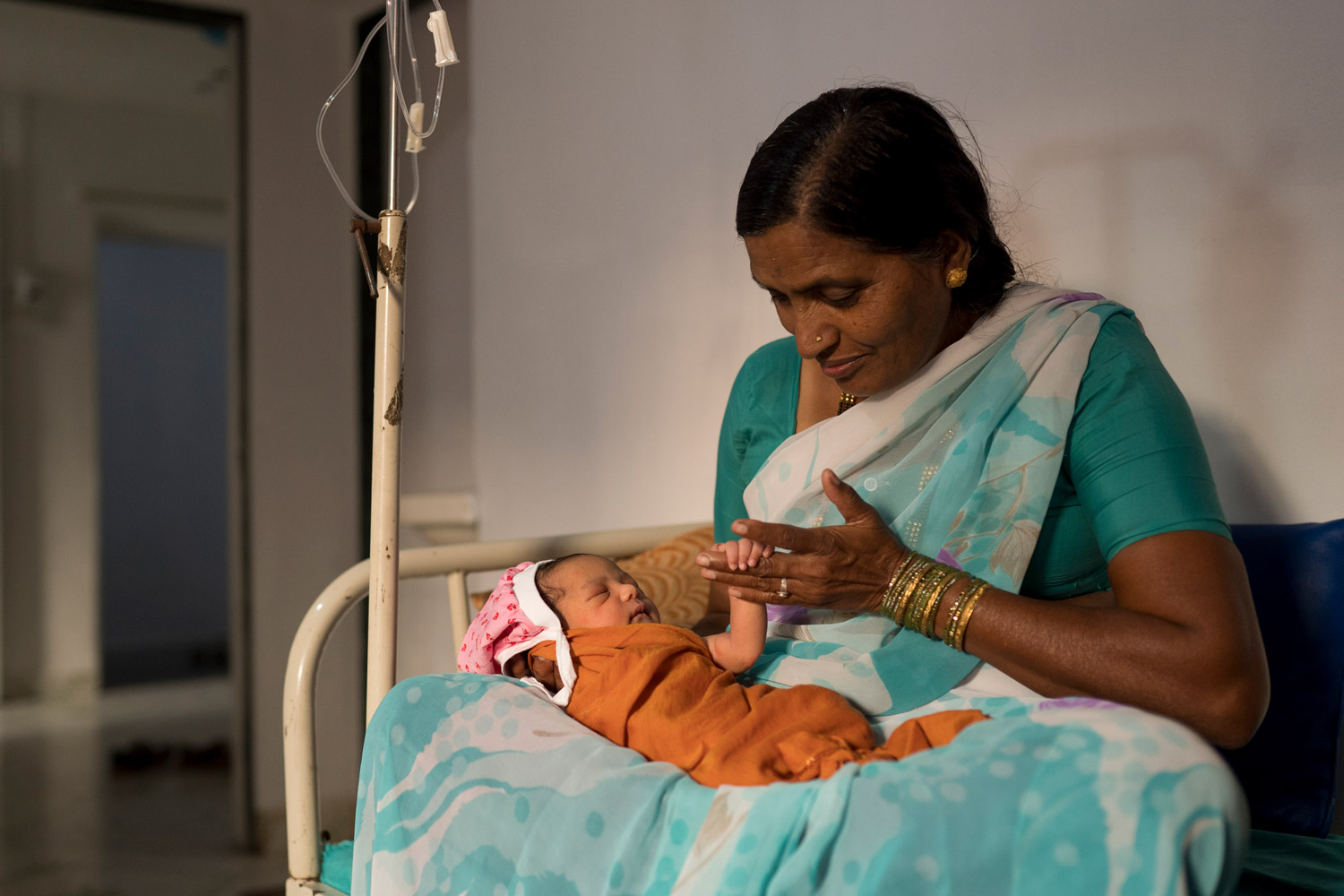
Kartiki’s grandmother plays with her hand.
The first thing Vimal asked Dr Rakh after delivering her baby girl was if her husband was angry. Nurse Seema, who was the liaison between the delivery room and the waiting area where Bhupendra, her husband, awaited news, replied, “Your husband is fine.” Vimal’s face lit up.
On January 6, 2012, Vimal and Bhupendra Chaudary crossed the threshold of the Medicare Hospital. Vimal – fair skin and dark hair – wore a white sari with red and gold motifs that covered a rotund belly occupied by a nine-month-old resident waiting for freedom. Vimal didn’t know it at the time, but she was going to inaugurate Dr Rakh’s new undertaking. She was already a mother to a son and a daughter, but the latter died shortly after birth. Three days later, Vimal was holding her third child, a girl.
That was the first time Dr. Rakh decided not to charge the parents for the delivery. He also had another idea: he decided to celebrate the newborn’s arrival. He opened his wallet and gave a few hundred rupees to the hospital receptionist, who ran to a nearby florist and pastry shop and bought a chocolate cake and a bouquet of red roses. He improvised by gathering nurses and family members in his office, and there on the ninth of January, the first party was held to initiate, the first free delivery, the kick-off to the “Save the Girl Child” campaign”.
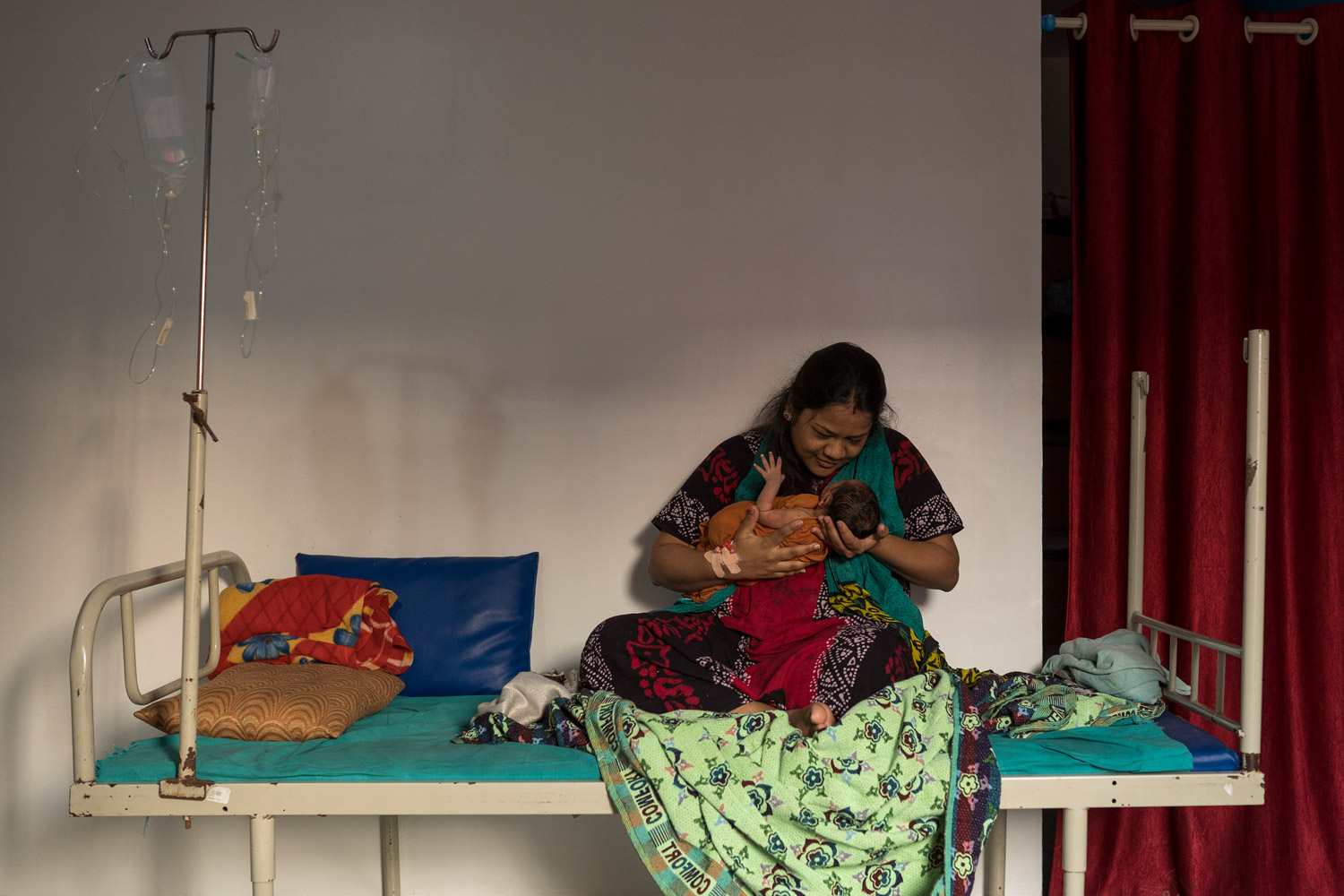
Tejashree sings to Kartiki, her daughter who has just been born.
Tejashree and her husband Keitan are two representatives of what is contemporary India – computer artisans writing code on marathonian days in front of a screen for a company located on the other side of the world. Sitting in a delivery ward surrounded by their closest family, they look at their most precious gift and smile at each other. The orange curtains in the small room warm a white metal crib. In it rests Kartiki, a girl barely one day old who wanted to remain in the safety of her mother’s uterine embrace a little longer. Tejashree limits her movements to the essential, a scar crosses her lower abdomen horizontally and any movement is an arduous task.
A few steps away from them, nurse Seema turns off the lights in the room that in the past served as the hospital’s ICU. The same room where a few years ago Jaya hoped to gather enough strength to survive the operation that would free her limbs. Today a few beds pushed back against the walls occupy the space. Hospital staff strive to light dozens of candles, while a small bunch of roses and a cake rest on a table. The nurses smile. A girl is born and there is going to be a party.
Pieces of cake pass from hands to other people’s mouths. The participants in the celebration approach the cake, and take small portions to feed to the other participants. Each one picks up a rose and presents it to Tejashree, who ends up clutching a large bouquet of blooms. Keitan asks for silence and begins to speak, “Like my daughter Kartiki is welcome in this world, like we have celebrated the birth of her – I want all girls born in this world to be welcomed in this way and to never be less than boys.”
Watch Tejashree talk about the hospital and the doctor.
Vimal was the first mother – it’s been so long that Dr. Rakh remembers the name of the parents but not the daughters. “Sometimes parents can take weeks to baptise their children,” says the doctor. After Vimal’s daughter came Aditi and Madhuri, Naina and Pooja, later Pia and Sneha, Varsha, Sajili, Rohini, Radhika and then Deepa, Beenish, Jana, Rana, Ahana, Pooja, Dea and Manavi and so on, adding up to 1,700 girls with the arrival of Tejashree’s daughter, Kartiki.
Dr Rakh, blessed with a round face carved into gentle angles and a serene and comforting voice, says: “They called me Mad Doctor Rakh because I was celebrating the birth of other people’s girls.” More than 1,700 celebrations and counting – the 1,700 daughters of Dr Rakh.
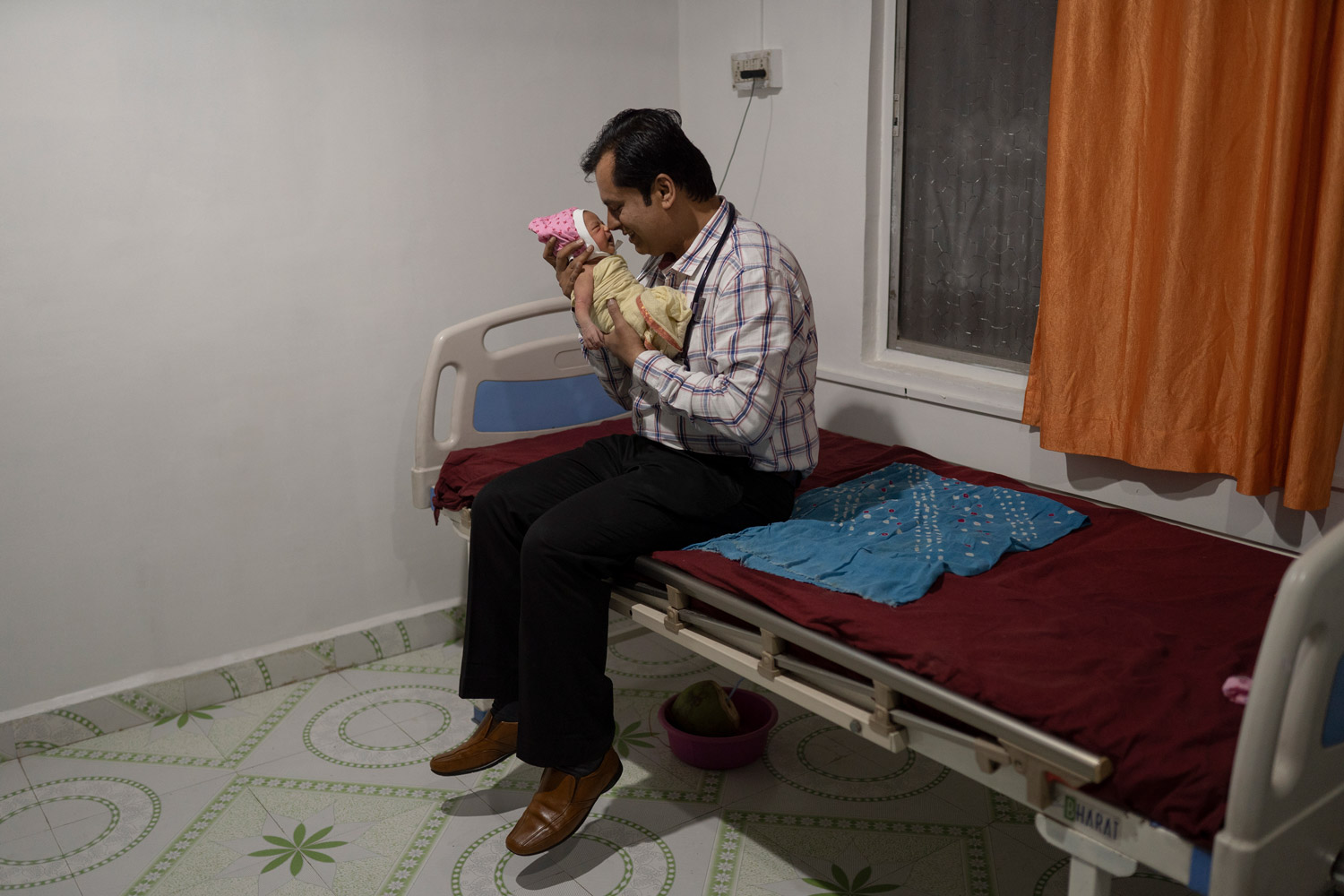
Doctor Rakh plays with Kartiki, a newborn girl in his hospital.
This reportage was made from more than five years worth of visits to Dr Rakh’s hospital. During the tsunami of infections that was the second wave of COVID-19 in India, Dr Rakh was forced to transform his hospital into a space to care for patients from the pandemic. Between 80 and 90 coronavirus patients arrived daily at the doctor’s small hospital. Oxygen cylinders – a rare commodity in India – occupied beds formerly inhabited by pregnant mothers. The doctor made the difficult decision to only treat COVID-positive mothers. It was an unprecedented situation that the doctor called “a war against the virus.” When the second wave subsided, the doctor resumed his work delivering female babies, leaving a small wing of the hospital to continue treating COVID patients.